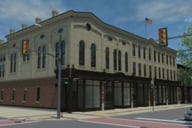You have /5 articles left.
Sign up for a free account or log in.
I shall the effect of this good lesson keep,
As watchman to my heart.
— William Shakespeare, Hamlet, Act I.iii
In the spring of 2008 I was certain our college would imminently be planning for the dedication of a new Student Center overlooking a much-loved pond known—as are such bodies along the Upper Mississippi River—as the Slough.
Financing was coming together, commitments for lead gifts had been secured and, as our tradition dictates, members of the campus community had begun to criticize the need for a new building. For at least the past 50 years, every major construction project at Augustana College has faced staunch opposition from a dedicated cadre for a fairly uniform period extending from 12 months prior to the groundbreaking until 12 hours past the dedication. Surely, this was a good omen.
Then came the fall of 2008. As the nation’s economy tanked, commitments were withdrawn, financing became unattainable, and the decision was made not to replace (for a third time) the “Student Center Coming Soon” sign that had twice found its way into the waters of the Slough.
I admit that, as a college president, having to step away from that project was not easy. It was professionally distressing and personally dispiriting. But the sour economy did nothing to mitigate Augustana’s need for more student activity and programming space, the kind of space that builds community. Sure, our Thomas Tredway Library had long ago acquired the mantle of the “campus living room”; its central location between academic and residential areas made it the most-visited structure on campus, and its coffee shop was the place for faculty and students to meet.
And that’s when my colleagues and I learned that listening is about more than conversations and campus forums. While those are the lifeblood of listening, of course, there also is much to be said for listening to the rhythms of a community.
We listened more closely, and heard that students preferred ease of access to digital resources over the chance encounter with printed periodicals. Our award-winning library staff had been paying close attention to such global trends, and had long before honed the focus of their work with students to emphasize discernment within a surfeit of knowledge over how best to leverage whatever might be at hand.
We kept listening still more closely, and added to our conversation voices far from campus. Geoffrey Freeman, the principal Shepley-Bullfinch architect who had done so much to make our Tredway Library the incomparable resource it was, wrote in an essay for the Council on Library and Information Resources that the genus and species of place he had done so much to develop now needed to be “reinvented.” Libraries, Freeman argues, need to evolve as catalytic places for community, contemplation and collaboration.
So we reinvented our library. The library now is part of a new Center for Student Life, thanks to a $21 million addition that nearly doubled the square footage of the building. The Center for Student Life is home not only to the re-envisioned library, but also a student center and our main dining facility. Like a family’s home, it includes the functions of study, living room and dining room under one roof. To make room for these features and to improve the function of our library, we reduced the size of our library collection by over 20%.
But in reducing the size of the collection, I also learned a lesson regarding the other half of communication. Specifically, no matter how much you say, write and gather around a given message, there simply is no reason to suspect you’ve spoken well enough, or been heard. As we began the process of removing unused material and other library resources easily duplicated by digital means, recycling became challenging and a 1970s-era photostatic reprint of a Chinese collection that no one had ever checked out became controversial.
So we communicated yet more robustly, and gave academic departments and individual members of the campus community the right to save unused books from the recycle bin. And soon another lesson was learned: no matter how strong the storm may blow, no tempest can contend with a trend. Today’s students do not access and make use of information as their predecessors did, and no matter how earnestly resistance to change attempts to trump imagination, within communities such as ours we must always expect imagination will win.
And this is precisely what happened with the Center for Student Life at Augustana College. It gave me great joy to see and hear the response of our students as they explored not only improved library facilities, but a new marché-style dining hall, gathering spaces of all sizes, and academic support and student life offices. In their eyes, as well as in those of colleagues, I see evidence of the fact that even in a possibilities-based ecosystem like a college, sometimes you need to see to believe.
The final lesson I hope to hold “as watchman to my heart” is the value of being open to an ending not apparent at the beginning. Perhaps no one saw as clearly as my colleague Carla Tracy, director of Augustana’s Thomas Tredway Library, what this ending might be—but her vision inspired us. By the mid-point of this project, she was ahead of us all in seeing the possible. That she would be named Academic Librarian of the Year by the Illinois Association of College and Research Libraries in this year, of all years, is testament to her vision and leadership.
Steven Bahls, President
Augustana College

Want articles like this sent straight to your inbox?
Subscribe to a Newsletter





